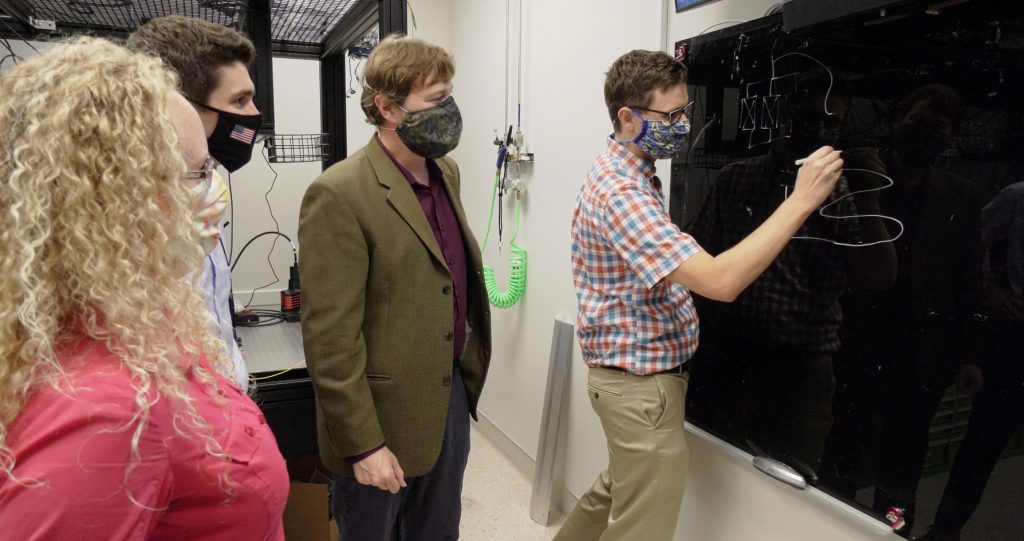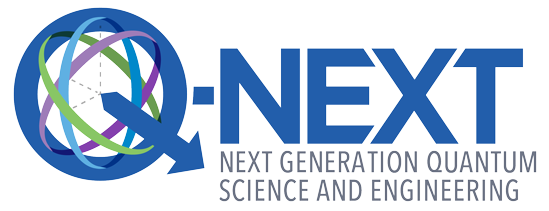
In 1998, scientist Thaddeus Ladd started graduate school at Stanford University knowing he wanted to find a practical way to build a quantum computer. A flurry of research publications at the time were describing new or newly discovered algorithms and physics principles that might be applied in the future construction of a quantum computer, and researchers were proposing quantum-computer schemes left and right.
“I went to grad school thinking, ‘I’m going to figure out the practical way to do this, to figure out which of these proposals are going to work,’” Ladd said. “I’m still doing that 23 years later.”
Ladd, a principal scientist at HRL Laboratories, a Q-NEXT industry partner, is also the co-design engineer for the Q-NEXT Quantum Communication Thrust. In that role, he assesses HRL’s and other industry partners’ areas of overlap with Q-NEXT’s mission to develop the science and technology for distributing quantum entanglement, provides direction for the collaboration, and helps build technologies for quantum networks.
Ladd started at the Malibu-based company in 2009, around the time that certain key technologies were taking a promising turn, auguring a favorable outlook for the realization of a practical quantum computer. Tech company investment in quantum science and engineering was taking off, and the term “quantum industry” was breaking into the lexicon.
“All these different factors led multiple commercial entities to say, ‘Oh, quantum computers. Maybe we should start paying attention,’” Ladd said. “Now the world is completely different.”
Different in ways both sweeping — one can barely open a popular-science website without reading about the race to build a practical quantum computer — and particular. For one, the quantum industry is now paying closer attention to new and emerging materials with particular promise for quantum information, such as silicon carbide.
Until about 20 years ago, silicon carbide was seen as nothing grander than an abrasive or a go-to for strengthening metals. As its use in high-power electronics has advanced the material in the last two decades, a number of researchers, including several Q-NEXT partners, have recognized it as a potential goldmine for the development of quantum devices.
Ladd manages an integrated quantum photonics program at HRL, leading a team that explores silicon carbide for developing qubits and quantum interconnects. The group collaborates with Q-NEXT partners at Stanford University, the University of Chicago and the University of Illinois at Urbana-Champaign to advance silicon carbide for quantum communication, for example, in quantum repeaters.
“At HRL we can do real scalable photonics fabrication and talk seriously, and not just abstractly, about manufacturability for various purposes. Add to that capability a group of people who are interested in these quantum science problems, interested in quantum communication, and there are a lot of ripe research problems there.”
Ladd says the silicon carbide work is exciting not only because the material is so promising, but also because the state of research is perched at one of those tantalizing inflection points in tech R&D: Scientists are fairly certain the quantum engineering and manufacturability problems of silicon carbide can be solved, but not yet how.
“The truth is that silicon carbide work is not mature enough yet to put all of these separate efforts together. But the potential is there,” he said. “What needs to mature is the level of research — and we’re at exactly the level of research that Q-NEXT is all about. Many of the players are well-positioned to move this material to the next level.”
Ladd started HRL’s quantum photonics program in about 2015, building on the company’s strengths in photonics and materials science. The program eventually outgrew its original lab space, and in 2020, HRL constructed a new laboratory to accommodate additional personnel and equipment.
“At HRL we can do real scalable photonics fabrication and talk seriously, and not just abstractly, about manufacturability for various purposes,” he said. “Add to that capability a group of people who are interested in these quantum science problems, interested in quantum communication, and there are a lot of ripe research problems there.”
The opportunity to fully immerse oneself in those research problems is what has kept Ladd at HRL for 12 years. HRL supports its research-driven mission with the tools and facilities found primarily in private enterprise. It’s the perfect problem-solving setting, he says, especially for someone who enjoys the nitty-gritty work of tackling less academic engineering challenges.
“What makes HRL unique is that it has the research agility of a national lab or academic institution and the tooling and processes for more industrial research,” he said. “It’s good for people like me who are a little more inclined to focus on those technology-advancing problems that aren’t as easy to publish. HRL provides an environment that is focused on applied research and development.”

Investigations in silicon carbide are only one slice of his work. In addition to the continued effort to develop practical quantum computers out of silicon quantum dots, Ladd is also advancing quantum simulation research at HRL as its group lead for quantum theory and simulation. The role reflects a turn in his career from the experimental to the theoretical: Even as he carried out experimental studies on quantum dots for his doctoral and postdoctoral work at Stanford, he became more interested in simulation.
“By the time I got to HRL, I considered myself as having more expertise in doing simulations of systems than in doing experiments in those systems. I kind of declared that I’m going to be HRL’s engineering-through-simulation guy,” he said.
The HRL quantum simulations group works with scientists at Argonne National Laboratory, the host lab for Q-NEXT, to develop metrics and goals for quantum communication systems, adapting an Argonne-developed code package called SeQUeNCe to build virtual quantum networks and investigate their responses to various inputs.
As a manager and principal investigator at HRL, Ladd works to bring it all together — simulating networks and systems, developing quantum materials, and engineering those materials for quantum network devices.
“We’re identifying the applications, impact on society, technological advancements needed to get there. As performers in this field, we have better information about the state of the art than you get from the popular press. We’re making an honest appraisal of the technology and what needs to happen to develop it for basic science, the government and commerce.”
The integrated nature of this work also gives him the bird’s-eye perspective needed to chart a path to the eventual production of these devices, and that’s exactly what he does as a lead in the Q-NEXT technology roadmap effort. Once complete, the roadmap will plot an R&D course to bring entanglement distribution technologies — in communication, computing and sensing — to the public in 10 to 15 years.
“We’re identifying the applications, impact on society, technological advancements needed to get there,” he said. “As performers in this field, we have better information about the state of the art than you get from the popular press. We’re making an honest appraisal of the technology and what needs to happen to develop it for basic science, the government and commerce.”
While Ladd’s path to a leader in quantum information science at HRL was straightforward, the short history of the field has not been. Just during the span of his two-decade career, Ladd can cite numerous examples of viable or even flourishing quantum technologies that were once deemed to be impossible or at an impasse.
The lesson for those planning to enter the quantum workforce? Expect pivotal changes. Quantum information science is young and evolving quickly.
“The decisions that led me to go to HRL or apply for a faculty position in the late aughts aren’t relevant to what decisions a young person has to make today in 2021. The technology is in a completely different place,” Ladd said. “Instead of looking at someone’s biography from decades back, be aware of everything going on around you when making career decisions. Because today, everything is different.”
This work was supported by the DOE Office of Science National Quantum Information Science Research Centers.
